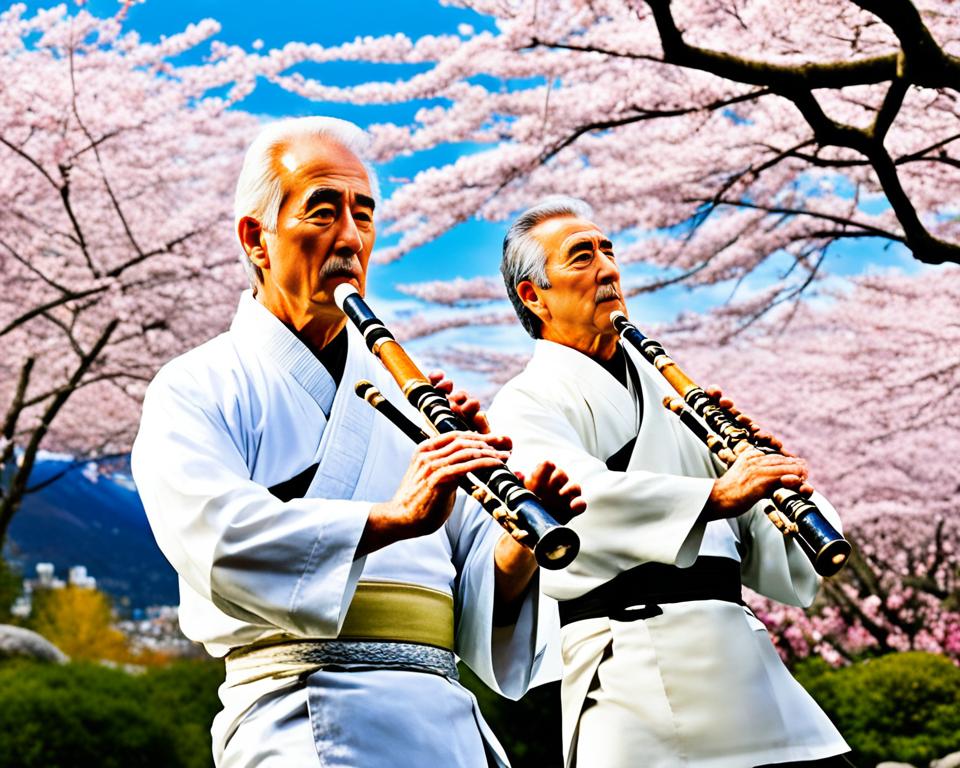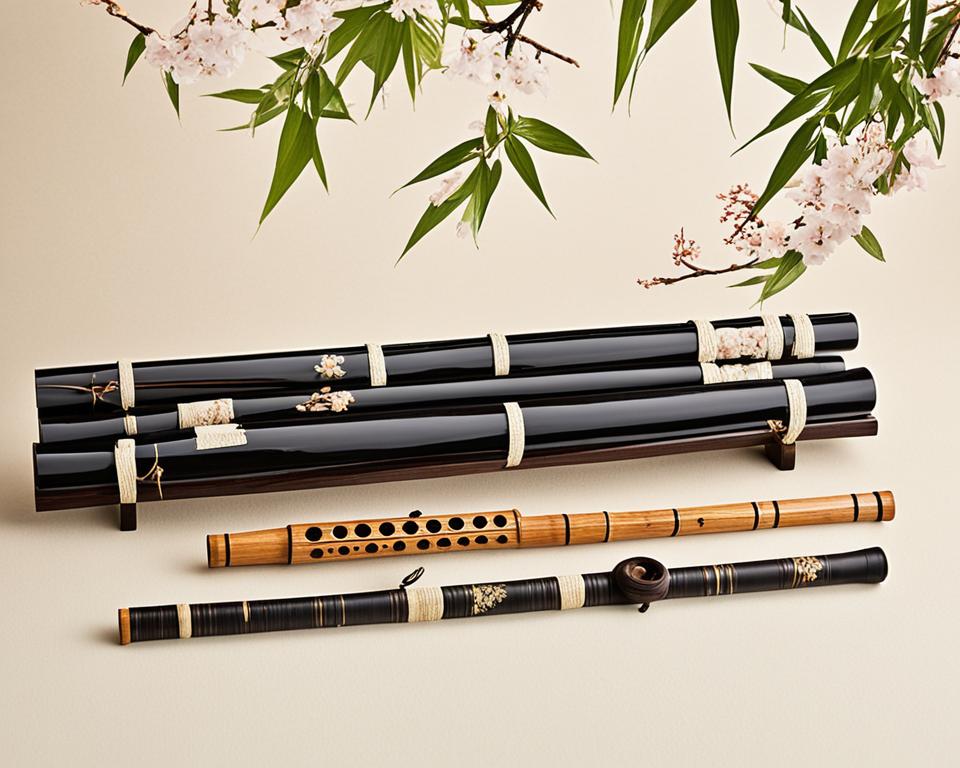The shakuhachi is a captivating instrument from Japan. It has a deep connection to the country’s culture. It started in Zen Buddhist monasteries in medieval Japan. Now, it’s a symbol of Japanese art and spirituality, loved worldwide for its haunting sounds.
This traditional Japanese flute is closely linked to Zen Buddhism. Its history shows how it was shaped by the spiritual and musical traditions of this sect. It’s a key part of Japan’s cultural identity.
The shakuhachi is made from bamboo. Its design and playing style give it a unique sound. This sound is perfect for meditation and self-reflection. It’s a favorite in Japanese music and folk music.
Read interesting things at : info-kirara
Key Takeaways
- The shakuhachi is a traditional Japanese bamboo flute with deep roots in Zen Buddhism
- Its haunting, meditative tones have made it a symbol of Japanese artistry and spirituality
- The shakuhachi’s unique construction and playing techniques contribute to its distinctive sound
- It is a highly respected and beloved woodwind instrument in Japanese music and culture
- The shakuhachi’s global reach and influence have captivated audiences around the world
Origins and History of the Shakuhachi
The shakuhachi flute has a long history, dating back to the 7th century. Zen Buddhist monks first used it for meditation and deep thought. They believed its unique sound could lead to a state of calm and mindfulness.
Zen Buddhist Influence
The flute’s connection to Zen Buddhism is clear in its history. Monks played it in rituals and meditation, finding it helped them connect with nature. This connection made the flute a key part of their spiritual practice.
Evolution from Ancient Flutes
Over time, the shakuhachi changed from simple flutes for rituals to a versatile musical instrument. This change was shaped by Japan’s rich cultural heritage and its traditional Japanese music. These traditions were already a big part of Japanese life.
The shakuhachi’s shift from a Zen Buddhist tool to a respected instrument shows Japan’s deep respect for its history. It also highlights the importance of ancient flutes in Japanese culture.
The Shakuhachi’s Distinctive Construction
The bamboo flute, or shakuhachi, is a unique woodwind instrument known for its beautiful sound and deep history. It’s made from carefully chosen and shaped bamboo. This natural material gives the flute its resonant sound.
Bamboo is ideal for the shakuhachi because of its hollow, tubular shape and special sound properties. Skilled craftsmen shape each flute. They make sure the finger holes are in the right place and the mouthpiece is shaped just right. This creates the flute’s unique tone.
Bamboo: A Natural and Resonant Material
The flute’s hollow body makes the player’s breath sound hauntingly beautiful. The bamboo’s natural differences in thickness and density give each flute its own sound. This focus on detail and natural materials is what makes the shakuhachi special.
“The shakuhachi’s construction, including the placement of its finger holes and the shaping of the mouthpiece, is a testament to the centuries-old tradition of Japanese woodwind instrument making.”
Playing Techniques and Sound Production
Learning to play the shakuhachi, a traditional Japanese bamboo flute, takes a lot of knowledge about its playing techniques and sound production. The key to its beautiful sound is the player’s embouchure. This is how the lips, tongue, and mouth are placed and shaped.
Creating a good embouchure is key for the shakuhachi’s soft, haunting sound. With lots of practice, players learn to control their breath well. This lets them play with feeling and show off their musical expression.
Embouchure and Breath Control
The way a player forms their embouchure is crucial for the shakuhachi’s unique sound. A precise embouchure helps players move smoothly from soft sounds to loud ones.
Being good at breath control is also vital. It lets shakuhachi players hold notes long and add beautiful touches to their music. With lots of practice, they can control their breath to make a wide range of sounds, from very soft to very loud.
| Playing Technique | Description |
|---|---|
| Embouchure | The precise positioning and shaping of the lips, tongue, and mouth to produce the shakuhachi’s characteristic sound. |
| Breath Control | The ability to precisely regulate and control the breath to create dynamic, expressive phrasing and nuanced musical expression. |
Mastering playing techniques and sound production on the shakuhachi is a long journey. It needs hard work, patience, and a deep understanding of the flute. By improving their embouchure and breath control, players can bring out the best in this beautiful flute.
Shakuhachi in Zen Meditation and Spiritual Practice
The shakuhachi, a Japanese bamboo flute, is deeply linked to Zen Buddhism. It’s been a key tool for meditation and finding inner peace. Its haunting sounds help people reach a state of deep awareness and calm.
Zen monks have used the shakuhachi for centuries in their rituals. Playing it is like a meditation, focusing on making each note with breath. This focus and the flute’s sound help people become more mindful and peaceful.
“The sound of the shakuhachi is like the voice of the universe, speaking directly to the soul. It is a language that transcends words, connecting the player to the very essence of zen buddhism and the natural world.”
The shakuhachi is not just for Zen Buddhism. It’s also used in spiritual practice and mindfulness meditation. Its unique sound and playing technique attract those wanting to deepen their spiritual practice and find more inner peace.
The shakuhachi is a symbol of Japan’s rich culture, linked to Zen Buddhism. As people worldwide seek more mindfulness and meditation, the shakuhachi remains popular. It connects ancient Zen wisdom with today’s quest for spiritual growth.
Repertoire and Musical Styles
The shakuhachi’s music includes both traditional and modern pieces. At its heart are the Honkyoku, solo songs from the Zen Buddhist tradition. These pieces are known for their deep, spiritual feel.
Today, the shakuhachi also inspires new music. Composers worldwide love its unique sound and expressiveness. They create new works that blend traditional and modern styles.
Traditional Honkyoku Pieces
The Honkyoku are key to the shakuhachi’s music. They are complex, improvisation-based songs from Zen Buddhism. Each Honkyoku is a journey, showing the spiritual side of the instrument and the bond between the player and the music.
Contemporary Compositions
Recently, the shakuhachi has sparked a wave of new music. Composers from different places see its potential for expression. They mix traditional musical styles with modern methods and looks. These pieces show the shakuhachi’s wide range and its place in contemporary music.
| Traditional Honkyoku Pieces | Contemporary Compositions |
|---|---|
|
|
Notable Shakuhachi Masters and Performers
The shakuhachi, a traditional Japanese bamboo flute, has been championed by many virtuosos and masters. They have sharpened their skills to the highest level. They also helped keep and grow the instrument’s traditions.
Kinko Kurosawa is a top shakuhachi master from the 17th century. He started the Kinko school of shakuhachi playing. His work has deeply influenced the flute’s teaching and music.
Katsuya Yokoyama is another famous performer. He’s known for his instrumental virtuosity and new takes on the music. Yokoyama’s skill has won him praise worldwide as a leading ambassador of the shakuhachi.
Riley Lee, born in Australia, has greatly helped spread the shakuhachi to the world. He was the first non-Japanese to become a dai shihan, or grand master, in the Kinko school. Lee’s work in keeping the shakuhachi tradition alive has made him a highly respected figure in the shakuhachi community.
| Shakuhachi Master | Contributions | Legacy |
|---|---|---|
| Kinko Kurosawa | Established the Kinko school of shakuhachi playing, influential pedagogy and repertoire | Pioneering virtuoso of Japanese music |
| Katsuya Yokoyama | Renowned for his instrumental virtuosity and innovative interpretations | Leading ambassador of the shakuhachi globally |
| Riley Lee | First non-Japanese person to attain the rank of dai shihan (grand master) in the Kinko lineage, dedicated to preserving and promoting the shakuhachi tradition | Highly respected figure in the global shakuhachi community |
These shakuhachi masters and famous performers have made a lasting impact. They inspire musicians and keep the unique Japanese musical tradition alive.

The Shakuhachi in Japanese Culture and Art
The shakuhachi flute’s haunting tones have deeply touched Japanese culture, art, literature, and poetry. This ancient bamboo flute is a symbol of Japan’s rich artistic past. It has inspired many poets and writers to use its beauty in their works.
Influence on Literature and Poetry
The shakuhachi’s sound has been a big part of Japanese literature. Poets find inspiration in its sounds, linking them to the short life of humans. Haiku and tanka poems often use the shakuhachi to express deep thoughts and spiritual feelings.
“The lonely sound of the shakuhachi,
Echoing through the autumn woods,
Reminds us of the fleeting nature of life.”
Not just poetry, the shakuhachi has also touched Japanese literature, from novels to short stories. Writers use its sound to set a mood or show Japan’s cultural identity.
| Influential Japanese Works Featuring the Shakuhachi | Notable Authors |
|---|---|
| The Master of Go | Yasunari Kawabata |
| The Izu Dancer | Yasunari Kawabata |
| The Sound of the Mountain | Yasunari Kawabata |
| In Praise of Shadows | Junichiro Tanizaki |
The shakuhachi’s lasting impact on Japanese literature and poetry shows its deep importance. It’s a cultural symbol and a part of Japan’s artistic history.
Learning to Play the Shakuhachi
Learning to play the shakuhachi, a traditional Japanese bamboo flute, takes hard work and the help of skilled teachers. If you want to learn the shakuhachi, it’s important to find good educational resources and musical instruction.
Finding a Teacher and Resources
Learning shakuhachi often means getting lessons from a teacher one-on-one. You’ll learn from experts who know the instrument well. It’s key to find shakuhachi teachers who know a lot about the instrument and its music.
There are also many educational resources for learning the shakuhachi online. You can find videos, tutorials, and books on topics like how to hold the flute, control your breath, and play traditional songs.
| Resource | Description |
|---|---|
| Shakuhachi Lessons | Private or group lessons with experienced shakuhachi practitioners, focusing on technique, musicality, and repertoire |
| Instructional Videos | Online and DVD-based tutorials demonstrating playing techniques and musical styles |
| Shakuhachi Instruction Books | Comprehensive written guides covering the history, construction, and performance of the shakuhachi |
| Online Courses and Workshops | Virtual learning opportunities that provide in-depth instruction and interactive experiences |
With the help of skilled shakuhachi teachers and lots of educational resources, you can start a great journey in learning this unique instrument.
Shakuhachi Festivals and Events
Shakuhachi festivals around the world show how much people love this instrument. These events bring together fans, musicians, and experts. They offer musical performances, workshops, and talks on the shakuhachi’s history and culture.
These festivals are key spots for sharing knowledge and building a strong community. They’re held in places like North America, Europe, and Asia. They highlight the shakuhachi’s beauty and its wide appeal, drawing in both experts and beginners.
Events like the Kitakata Shakuhachi Festival in Japan and the International Shakuhachi Festival in the U.S. are must-sees. They let you hear the shakuhachi’s beautiful sounds. You’ll enjoy solo performances, group music, and talks on its link to Zen Buddhism and Japanese culture.
| Shakuhachi Festival | Location | Date |
|---|---|---|
| Kitakata Shakuhachi Festival | Kitakata, Japan | June |
| International Shakuhachi Festival | United States | Varies |
| European Shakuhachi Festival | Europe | Varies |
These shakuhachi festivals celebrate the instrument’s long history and its global appeal. They let visitors dive into the shakuhachi world and meet others who love it just as much.
The Shakuhachi’s Global Reach and Influence
The shakuhachi’s sound and deep spiritual feel have reached beyond Japan. It has touched the hearts of people and musicians all over the world. In recent years, the shakuhachi has become more popular and respected globally.
Players and composers from different cultures have taken to the shakuhachi. They love its unique way of expressing music. This has made the shakuhachi a part of many musical styles, making it a true voice of world music.
It’s now part of both classic and modern music. Its beautiful sounds and calming tones have won over many fans. This has led to new music and ideas that mix traditional Japanese music with other styles.
International Appreciation and Practice
More and more people outside Japan are learning about the shakuhachi. Musicians and those seeking spirituality find its sounds and connection to Zen Buddhism very appealing.
- Now, there are shakuhachi schools and workshops all over the world. They offer classes for both beginners and those already playing.
- Shakuhachi masters from Japan travel to share their skills. They inspire new players to explore the shakuhachi’s full potential.
- Working together, shakuhachi artists and musicians from different backgrounds have created new music. They mix traditional sounds with modern styles.
The shakuhachi’s popularity is growing, and so is its global impact. It’s bringing people together through music, creating a rich mix of cultures. This makes the shakuhachi a symbol of world music.
Preserving the Shakuhachi Tradition
Keeping the cultural heritage of the shakuhachi alive is crucial today. We need to teach new generations, keep up traditional craftsmanship, and support education. This helps people understand and love the shakuhachi more.
It’s key to pass on the musical heritage from old masters to new players. Through education and apprenticeships, we keep the shakuhachi’s skills and spirit alive. This way, the art will live on for many years.
Keeping the shakuhachi’s traditional craftsmanship alive is just as important. Skilled artisans are crucial. They know how to make the bamboo instruments. By teaching these skills, we keep the shakuhachi’s unique sound and look safe for the future.
| Initiative | Objective | Impact |
|---|---|---|
| Mentorship Programs | Passing on playing techniques and spiritual traditions | Ensures the continuity of the shakuhachi’s musical heritage |
| Craftsmanship Workshops | Preserving the art of shakuhachi construction | Maintains the instrument’s distinctive sound and character |
| Educational Initiatives | Fostering a deeper understanding and appreciation | Promotes the cultural significance of the shakuhachi |
By taking a full approach to cultural preservation, we can keep the shakuhachi’s legacy alive. This way, this special Japanese music will continue to move and inspire people everywhere.
“The preservation of the shakuhachi’s tradition is not just about preserving an instrument, but preserving a way of life, a connection to our cultural roots, and a profound spiritual practice.”
Incorporating the Shakuhachi into Modern Music
The shakuhachi flute is known for its deep roots in Japan’s culture. Yet, it has also made its mark in today’s music, sparking new collaborations and fusions. Musicians from all over the world have been drawn to its unique sound. They’ve used it in everything from jazz and world music to electronic and experimental music.
These new partnerships have opened up new possibilities for the shakuhachi. They’ve also made people around the world appreciate this special flute more. By mixing the shakuhachi’s sounds with modern music, artists are pushing the limits of genre fusion. They’re showing how timeless Japanese music can still captivate us today.
Exploring New Musical Frontiers
Terumasa Hino, a jazz master, has mixed the shakuhachi with jazz rhythms. Kitarō has taken it further with his electronic music, adding the flute’s sounds to his electronic beats. The shakuhachi has shown it can cross cultural and musical lines.
| Artist | Musical Genre | Collaborative Shakuhachi Integration |
|---|---|---|
| Terumasa Hino | Jazz | Incorporation of shakuhachi melodies into bebop rhythms |
| Kitarō | Electronic/Experimental | Layering shakuhachi tones over synthesized soundscapes |
| Silk Road Ensemble | World Music | Blending the shakuhachi with diverse global instrumentation |
The Silk Road Ensemble has beautifully combined the shakuhachi with music from around the world. They’ve mixed it with different instruments to create unique sounds. This has helped bridge cultural gaps.
These bold cross-cultural collaborations have shown the shakuhachi’s flexibility. They’ve also highlighted its ability to inspire new music and bring people together through art.

The Shakuhachi’s Unique Sound and Expressiveness
The shakuhachi, a traditional Japanese bamboo flute, is known for its captivating sound. Its haunting, breathy tones let musicians bring out a wide range of tonal qualities. This makes it stand out and draw people in.
The shakuhachi’s unique sound can bring peace or intense feelings, depending on how it’s played. Its ability to touch people deeply is a big reason why it’s loved. It connects with listeners on a deep level.
To play the shakuhachi well, you need to know how to control your breath and your mouth position. This skill lets players create a wide range of sounds. From soft whispers to loud, clear tones, the shakuhachi shows off the talent of its players.
“The shakuhachi’s sound has the power to transport the listener to a state of deep introspection and spiritual reflection.”
The shakuhachi is used in both traditional Zen meditation and modern music. Its musical expressiveness still moves and inspires people all over the world. Its special sound and deep emotions make it a beloved instrument in Japanese music.
Conclusion
The shakuhachi is a symbol of Japan’s culture and art. It has a deep history and spiritual meaning. It has moved from Zen Buddhist monasteries to the world stage, touching hearts everywhere.
This flute shows how music can cross borders and connect people. It reminds us of the value of traditional arts. The shakuhachi will keep inspiring people to learn and love this instrument.
The shakuhachi shows how music can bring people together. It has made a mark in Zen meditation and modern music. This flute will always represent Japan’s rich culture and its global impact.
